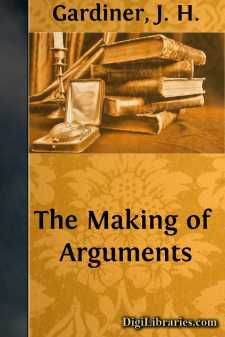Categories
- Antiques & Collectibles 13
- Architecture 36
- Art 48
- Bibles 22
- Biography & Autobiography 813
- Body, Mind & Spirit 142
- Business & Economics 28
- Children's Books 15
- Children's Fiction 12
- Computers 4
- Cooking 94
- Crafts & Hobbies 4
- Drama 346
- Education 46
- Family & Relationships 57
- Fiction 11829
- Games 19
- Gardening 17
- Health & Fitness 34
- History 1377
- House & Home 1
- Humor 147
- Juvenile Fiction 1873
- Juvenile Nonfiction 202
- Language Arts & Disciplines 88
- Law 16
- Literary Collections 686
- Literary Criticism 179
- Mathematics 13
- Medical 41
- Music 40
- Nature 179
- Non-Classifiable 1768
- Performing Arts 7
- Periodicals 1453
- Philosophy 64
- Photography 2
- Poetry 896
- Political Science 203
- Psychology 42
- Reference 154
- Religion 513
- Science 126
- Self-Help 84
- Social Science 81
- Sports & Recreation 34
- Study Aids 3
- Technology & Engineering 59
- Transportation 23
- Travel 463
- True Crime 29
The Making of Arguments
by: J. H. Gardiner
Categories:
Description:
Excerpt
CHAPTER I
WHAT WE ARGUE ABOUT, AND WHY1. What Argument is. When we argue we write or speak with an active purpose of making other people take our view of a case; that is the only essential difference between argument and other modes of writing. Between exposition and argument there is no certain line. In Professor Lamont's excellent little book, "Specimens of Exposition," there are two examples which might be used in this book as examples of argument; in one of them, Huxley's essay on "The Physical Basis of Life," Huxley himself toward the end uses the words, "as I have endeavored to prove to you"; and Matthew Arnold's essay on "Wordsworth" is an elaborate effort to prove that Wordsworth is the greatest English poet after Shakespeare and Milton. Or, to take quite different examples, in any question of law where judges of the court disagree, as in the Income Tax Case, or in the Insular cases which decided the status of Porto Rico and the Philippines, both the majority opinion and the dissenting opinions of the judges are argumentative in form; though the majority opinion, at any rate, is in theory an exposition of the law. The real difference between argument and exposition lies in the difference of attitude toward the subject in hand: when we are explaining we tacitly assume that there is only one view to be taken of the subject; when we argue we recognize that other people look on it differently. And the differences in form are only those which are necessary to throw the critical points of an argument into high relief and to warm the feelings of the readers.
2. Conviction and Persuasion. This active purpose of making other people take your view of the case in hand, then, is the distinguishing essence of argument. To accomplish this purpose you have two tools or weapons, or perhaps one should say two sides to the same weapon, conviction and persuasion. In an argument you aim in the first place to make clear to your audience that your view of the case is the truer or sounder, or your proposal the more expedient; and in most arguments you aim also so to touch the practical or moral feelings of your readers as to make them more or less warm partisans of your view. If you are trying to make some one see that the shape of the hills in New England is due to glacial action, you never think of his feelings; here any attempt at persuading him, as distinguished from convincing him, would be an impertinence. On the other hand, it would be a waste of breath to convince a man that the rascals ought to be turned out, if he will not on election day take the trouble to go out and vote; unless you have effectively stirred his feelings as well as convinced his reason you have gained nothing. In the latter case your argument would be almost wholly persuasive, in the former almost wholly a matter of convincing.
These two sides of argument correspond to two great faculties of the human mind, thought and feeling, and to the two ways in which, under the guidance of thought and feeling, mankind reacts to experience....


